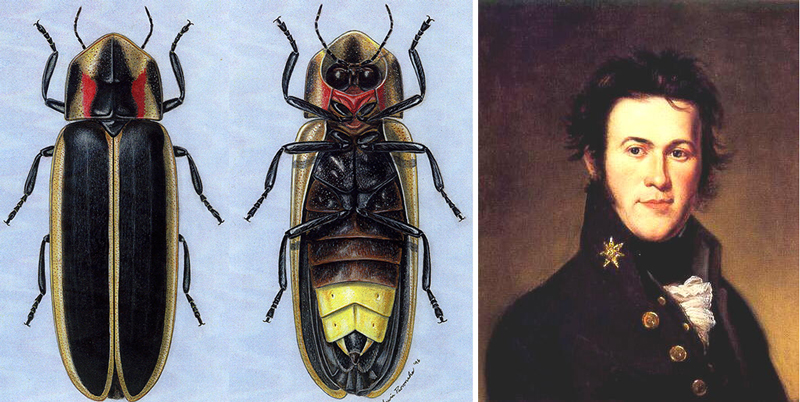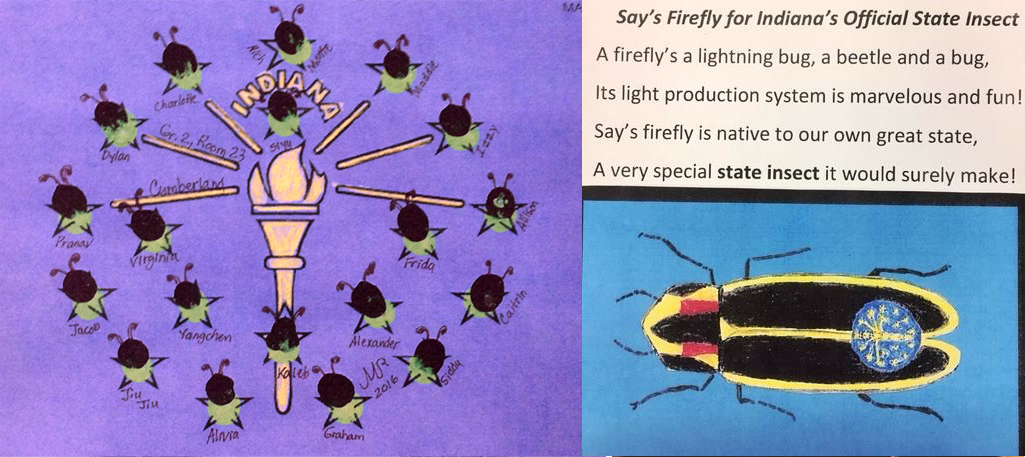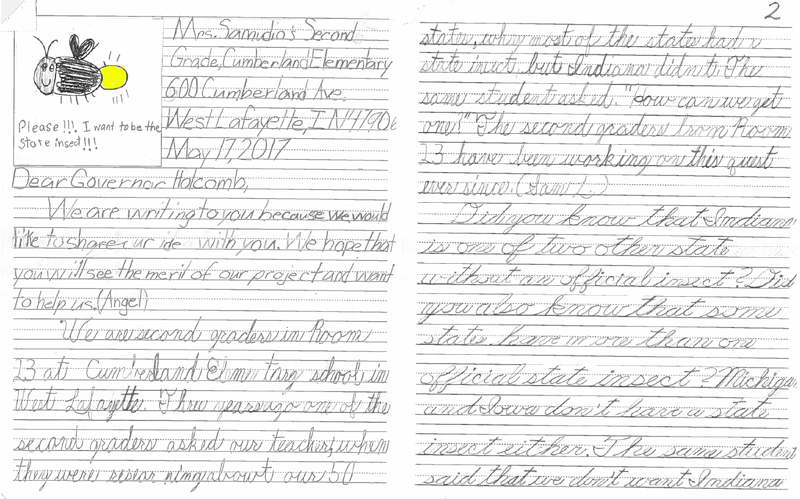What began as a geography lesson for students of Maggie Samudio’s second grade class at Cumberland Elementary School in West Lafayette, Indiana, took a detour to subjects of entomology, politics, and perseverance. After four years of lobbying, letter writing, and campaigning, Say’s firefly has become Indiana’s first state insect.
Four years ago Kayla Xu made a discovery while researching the 50 states for a class assignment. Noting other official state designations, Kayla observed that Indiana was one of only four states not to have designated an official state insect. Kayla asked Mrs. Samudio, “A lot of these states have state insects, why can’t we have one?”
Mrs. Samudio could have easily shrugged her shoulders, but instead she turned her student’s question into a class project. “That’s what teacher’s do. We take advantage of the teachable moment,” said Samudio.
Mrs. Samudio’s class focused on Say’s firefly (Pyractomena angulata) – which had been proposed for listing as the official state insect as early as 1998 by entomologist Tom Turpin of Purdue University. Say’s firefly was named by naturalist Thomas Say of Posey County in southern Indiana in 1824.
While there are more than 40 species of firefly present in Indiana, Turpin believed the Say’s firefly held special significance to the state. “This is the only one we have in Indiana that was named by Thomas Say. So that was the connection. If we wanted it to be a state symbol: it’s here in Indiana; it was named by a well-known Indiana naturalist who really was considered the father of North American entomology by many people,” said Turpin.

It should be noted that Thomas Say was himself a life-long student. A self-taught naturalist, Say helped to found the Academy of Natural Sciences of Philadelphia, and was the great-grandson of John Bartram, a self-taught botanist who contributed greatly to the collection and cataloging of North American native plants. In his lifetime, Say described more than 1,000 new species of beetles, more than 400 species of insects of other orders, and seven well-known species of snakes amongst other animals.
The class tapped into efforts already made by Professor Turpin and Arwin Provonsha of Purdue’s entomology department and wrote letters to every state official the class could find. Turpin visited Mrs. Samudio’s class to teach the students about fireflies, further illuminating their knowledge of the beetle and sparking an interest in insects in general. And that’s the whole idea behind official state insects in the first place.
Why a State Insect?
California was the first of the United States to select a state insect. The California dogface butterfly (Zerene eurydice) was officially adopted as its state insect in 1929, the result of a statewide poll of all the active entomologists in the state in an effort to elevate the field and increase public interest in entomology.
In the intervening years nearly every state has adopted a state insect. Indiana joins Pennsylvania and Tennessee in recognizing fireflies (Photuris pennsylvanica and Photinus pyralis, respectively). Many other states recognize bees, butterflies, dragonflies, and lady beetles – though some, such as Rhode Island (the American burying beetle) and South Carolina (the Carolina mantis) favor more unusual insects. Fellow firefly fan Tennessee is the most entomologically exuberant – recognizing a total of 4 state insects!
But meanwhile, back in Indiana…
After an extensive letter-writing campaign by Mrs. Samudio’s students, State Senator Ron Alting (a Republican) took up the student’s cause, introducing a Senate version of the bill. Representative Sally Siegrist, (Republican) authored the house version of the bill and Representative Sheila Klinker (Democrat) co-authored. Rep. Klinker also visited the class to let the students know she would be backing the bill. The student’s had gained rare, bipartisan support in both chambers.
Mrs. Samudio’s class went to work, lobbying on behalf of their bill. Her students created a Facebook page and even testified before the House Natural Resources Policy Committee to make the case for Say’s.

Unfortunately, the help of government officials, and the students’ own lobbying efforts were not enough to make passage of the bill a slam-dunk. Over the years the bill was referred to various committees but never came up for a vote.
“After having 5 pieces of legislation in the Senate and House over the past two years, that never made it out of committee, we had to try a new approach,” said Mrs. Samudio. In May 2017, the students wrote directly to Governor Eric Holcomb, who took up the students’ cause and initiated a letter-writing campaign, encouraging students to send letters of support to his office, promising to share them with the General Assembly. Mrs. Samudio’s class were joined by hundreds of students from across the state in writing letters to Governor Holcomb outlining the finer points as to why Indiana needed a state insect, and why the Say’s firefly should be it.

True to his word, Gov. Holcomb shared these letters with lawmakers and the bill finally cleared the General Assembly with near-unanimous support.
Gov. Holcomb honored the students of Cumberland Elementary by holding the signing ceremony at their school on March 23rd, 2018. During a special assembly, students and teachers wore day-glo green and yellow and the “Firefly Kids” – those who are, or have been students of Mrs. Samudio – wore special Say’s Firefly t-shirts.
To greet Governor Holcomb, the gym lights were turned off and, in the darkness, students flashed hand-held lights like their insect kin while a soundtrack of crickets played in the background. When the lights came up, Governor Holcomb made his way to the center of the gym, along with other elected and school officials including State Representatives Siegrist and Klinker, State Senator Alting, and of course, the original “Firefly Kid” – Kayla Xu. During the signing, Gov. Holcomb held the pen along with Kayla, the two of them signing the bill together.

On Facebook, Gov. Holcomb said of the achievement, “This is a big deal to young students around the state who have reached out to us in support,” adding “this has taught students a great deal about how our lawmaking process works—and that if they are engaged, they can make a real difference.”
For Mrs. Samudio, it’s the culmination of her “teachable moment” from years prior, and a real win for her students. “This was and has been a student-driven project initiated by Kayla when she was 7 years old in my 2nd grade class. She’s in 5th grade now. She is so proud and excited.”
Having caught the bug – Kayla and Mrs. Samudio aren’t stopping with Indiana. When asked “What’s next?” Mrs. Samudio has replied: “Kayla and I plan to pursue asking that the monarch be named as national insect. We would also like for it to be added to the logo for the North American Leadership Summit. We wrote to the three leaders [of the summit] in 2016 and promptly received a response from Mexico. They loved the idea, and referred to the monarch in their letters as ‘the wings that unite us’.”



